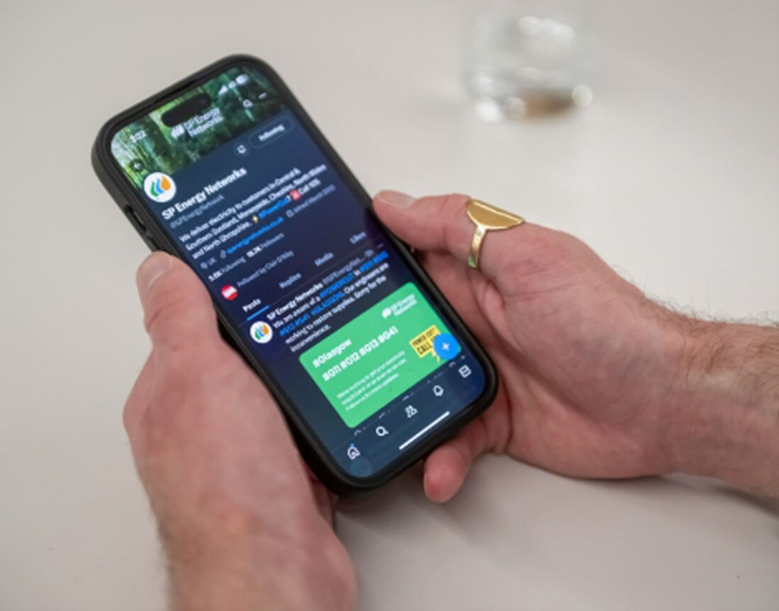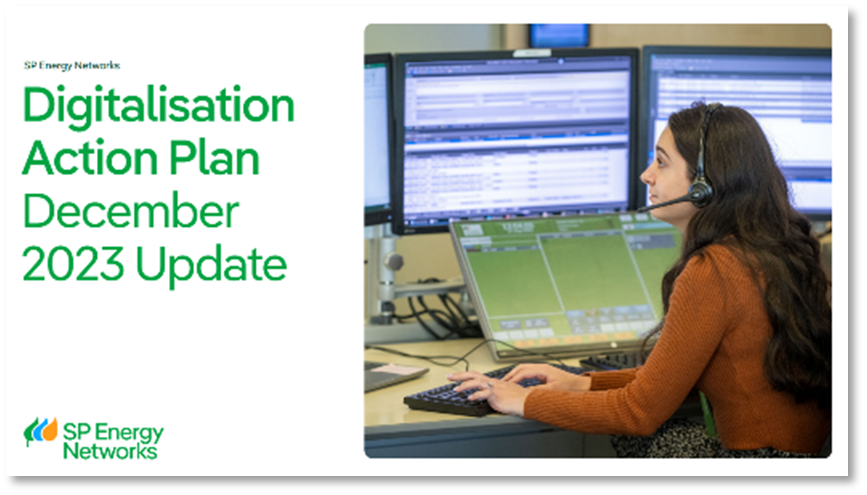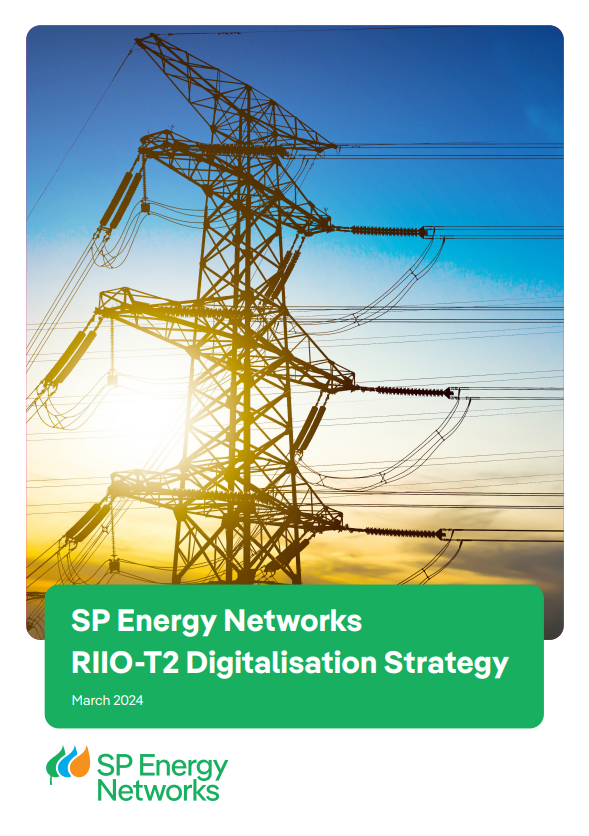This blog was shared in 2024 during the development of our RIIO-T3 Business Plan. The plan has now been published and is available to view online.
Blog by Lynda Ward, SP Energy Networks Transformation Director
 I’m pleased to share the next in the series of blogs linked to the delivery of our RIIO-T3 Business Plan. In this blog, I discuss how digitalisation will enable us to drive the modernisation and decarbonisation of our energy system. If you’re looking for a short summary of this blog, scroll to the end or click here for the top 3 key points. Look out for future blogs related to this topic which will focus on Data and Innovation.
I’m pleased to share the next in the series of blogs linked to the delivery of our RIIO-T3 Business Plan. In this blog, I discuss how digitalisation will enable us to drive the modernisation and decarbonisation of our energy system. If you’re looking for a short summary of this blog, scroll to the end or click here for the top 3 key points. Look out for future blogs related to this topic which will focus on Data and Innovation.
Introduction
As a transmission and distribution network owner, we play a critical role in enabling the transition to a cleaner, future – supporting both the Scottish and UK Government to reach their Net Zero targets.
Our RIIO-T3 Business Plan, due to be published in December this year, will set out proposed investment in the transmission network for the 5 years between 2026 to 2031. It will increase the security of energy supply, help to protect consumers from the dangers of climate change, generate investment that delivers growth and green jobs.
This blog is part of a series where we hear from different teams involved in developing our RIIO-T3 Business Plan.
 Before we kick off, what do we mean by “digitalisation?” It’s how business systems and processes are adapted to be more efficient, productive and cost effective through the use of digital technologies. In our home lives, we’ve seen huge changes arising from the internet and technologies like smart phones and smart devices. In the energy sector, digitalisation presents us with the opportunity to generate efficiencies whilst enabling our network to support the energy transition.
Before we kick off, what do we mean by “digitalisation?” It’s how business systems and processes are adapted to be more efficient, productive and cost effective through the use of digital technologies. In our home lives, we’ve seen huge changes arising from the internet and technologies like smart phones and smart devices. In the energy sector, digitalisation presents us with the opportunity to generate efficiencies whilst enabling our network to support the energy transition.
Digitalisation will improve the services provided to our customers and stakeholders while leaving no one behind. It will make our operations more efficient, saving customers money on their bills, and drive better engagement and opportunities for our people. It will enable us to maximise the use of our assets and protect security of supply all while working towards the UK’s Net Zero target.
Digitalisation Action Plan
 In December 2023, we published the latest update to our Digitalisation Action Plan. This update outlines the progress we have made in delivering our wide ranging and ambitious RIIO-ED2 programme of work. These projects and initiatives will bring many benefits for our customers and stakeholders, while also contributing to delivering a modernised energy system for the transition to Net Zero.
In December 2023, we published the latest update to our Digitalisation Action Plan. This update outlines the progress we have made in delivering our wide ranging and ambitious RIIO-ED2 programme of work. These projects and initiatives will bring many benefits for our customers and stakeholders, while also contributing to delivering a modernised energy system for the transition to Net Zero.
Some highlights featured in this update include:
Since June 2023, we have invested £22.5m million in our digital initiatives to align with our data and digitalisation strategies and we are on track to deliver against our RIIO-2 commitments.
Data is an important key enabler of a decarbonised, decentralised, and digitised energy future. It’s the tool that will bridge the gap between where we are now versus where we need to be – to achieve Net Zero by 2050 (2045 in Scotland). In the last year, our Open Data team have successfully facilitated over 200 requests for access to our data. This has included requests for information on the location of our network assets, the capacity of our network, and the investments we have delivered.
A project underway to scan and digitalise 450,000 historical land rights contracts. These contracts date from 1920 to 2020 and this activity will take approximately 16 months to complete.
There will be further updates to our Digitalisation Action Plan in June 2024, and again in December 2024 when we will also be publishing the RIIO-T3 Business Plan.
SP Transmission Digitalisation Strategy
 In March 2024, we published our SP Transmission Digitalisation Strategy, the first to focus on our transmission licence. This Strategy calls out the specific projects that are being delivered as part of our RIIO-T2 Business Plan (2021-2026). In parallel with this, we are creating our RIIO-T3 Business Plan including the development of a transformational Digitalisation Strategy for SPT. There are a number of key areas for Digitalisation that we believe will be appropriate for our RIIO-T3 Business Plan. These include:
In March 2024, we published our SP Transmission Digitalisation Strategy, the first to focus on our transmission licence. This Strategy calls out the specific projects that are being delivered as part of our RIIO-T2 Business Plan (2021-2026). In parallel with this, we are creating our RIIO-T3 Business Plan including the development of a transformational Digitalisation Strategy for SPT. There are a number of key areas for Digitalisation that we believe will be appropriate for our RIIO-T3 Business Plan. These include:
A continued focus on data
Optimised asset operation
Project design and delivery
Customer and Stakeholder solutions
Our wider strategy for SPT also heavily relies on data and digital solutions and we expect our RIIO-T3 Business Plan to significantly increase the investment in non-operational IT and telecoms above that planned in RIIO-T2.
An interesting case study featured in our SP Transmission Digitalisation Strategy is our SPT Generation Heatmap. This is a live example which shows the power of using data and stakeholder feedback to create useful and interactive data visualisations in an open and transparent way.
Stakeholder Engagement
Our approach to developing our transformational Digitalisation Strategy for SPT will be stakeholder driven. During 2024, we will undertake a range of activities to engage internally and externally and use the feedback received from this to inform the development of our RIIO-T3 plan. We would very much welcome input on our plan via our Digitalisation Strategy feedback form on visit the dedicated Digitalisation and Data page on our website.
Members of our Independent Net Zero Advisory Council (INZAC) will be supporting the development of our Business Plan, scrutinising both the technical plans as well as ensuring any emerging customer issues are fully considered.
You can be part of shaping our plans - Register as a Stakeholder to be kept up to date with wider engagement opportunities (tick ‘Data and Digitalisation’).
The top 3 takeaways from this blog are:
Stay up to date via our dedicated RIIO-T3 page which will be updated regularly with our latest blogs, progress and opportunities for engagement.
If you have any enquiries about our RIIO-T3 Business Plan, please email us on riio-t3pmo@spenergynetworks.co.uk